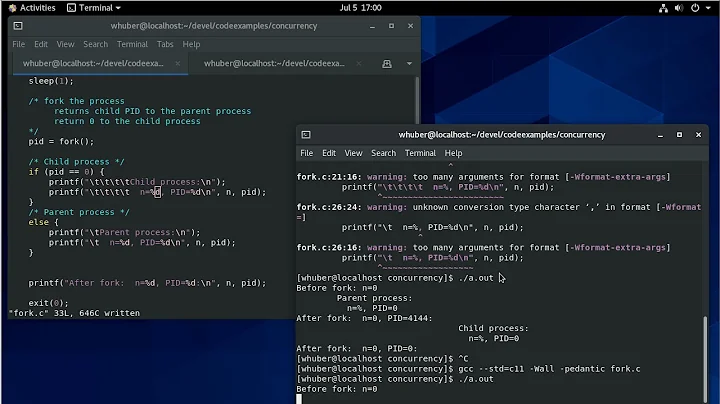Regarding background processes using fork() and child processes in my dummy shell
You do not want to use the double-fork() method in a shell - that is for writing daemons that specifically want to escape from supervision by the shell that ran them.
Instead, the way to duplicate the behaviour of & in existing shells is to call fork(), then in the child call setpgid(0, 0); to put the child into a new process group. The parent just continues on (perhaps after printing the PID of the child) - it doesn't call wait().
Each terminal can have only one foreground process group, which is the process group which is currently allowed to send output to the terminal. This will remain the process group of which your shell is a member, so your shell will remain in the foreground.
If a background process group tries to read from the terminal, it will be sent a signal to stop it. Output to the terminal is still allowed - this is normal (try ls & in your regular shell). To implement the fg command in your shell, you will need the tcsetpgrp() function to change the foreground process group.
You will also want to call waitpid() with the WNOHANG option regularly - say, immediately before you display the shell prompt. This will allow you to detect when the background process has exited or stopped (or alternatively, you can handle the SIGCHLD signal).
Related videos on Youtube
tlw11591
Updated on August 22, 2020Comments
-
tlw11591 over 3 years
I'm trying to create a simple shell program in C. What I need it to do is provide the user with a prompt in which they can run other local programs. I can do that part fine, using a fork() in which the parent process waits() on the child,and the child execvp()'s the program.
However, if the '&' character is appended to the end of the user's command, I need their program to run in the background, meaning I need the parent to NOT wait on the child process but instead immediately return the prompt to the user, while allowing the background process to continue to run, but not allowing it to display anything on the screen. I just want to be able to check that it still exists via ps command.
I tried to understand the idea behind using fork() to create a child, then have the child fork() again to create a grandchild of sorts, then immediately exit()-ing the child process. i.e., orphan the grandchild. Supposedly this allows the parent to still wait on the child, but since the child effectually ends almost immediately, it's like it doesn't wait at all? Something about zombie madness? I don't know. Several sites I've come across seem to recommend this as a way to run a process in the background.
However, when I try to do this, I get wild things happening with the flow of the program, the 'background' process continues to display input on the screen, and I'm really not sure where to go from here.
This is my implementation of the code, which I'm sure is quite wrong. I'm just wondering if this whole grandchild thing is even the route I need to take,and if so, what's wrong with my code?
36 int main(int argc, char *argv[]) 37 { 38 char buffer[512]; 39 char *args[16]; 40 int background; 41 int *status; 42 size_t arg_ct; 43 pid_t pid; 44 45 while(1) 46 { 47 printf("> "); 48 fgets(buffer, 512, stdin); 49 parse_args(buffer, args, 16, &arg_ct); 50 51 if (arg_ct == 0) continue; 52 53 if (!strcmp(args[0], "exit")) 54 { 55 exit(0); 56 } 57 58 pid = fork(); //here I fork and create a child process 61 62 if (pid && !background) //i.e. if it's the parent process and don't need to run in the background (this is the part that seems to work) 63 { 64 printf("Waiting on child (%d).\n", pid); 65 pid = wait(status); 66 printf("Child (%d) finished.\n", pid); 67 } 68 else 69 { 70 if (background && pid == 0) { //if it's a child process and i need to run the command in background 71 72 pid = fork(); //fork child and create a grandchild 73 if (pid) exit(0); //exit child and orphan grandchild 74 75 execvp(args[0], args); //orphan execs the command then exits 76 exit(1); 77 78 } else exit(0); 79 } 80 } 81 return 0; 82 }P.S. To be clear, I need the process that I'm running in the background to never make a sound again, even if it's got an infinite loop of print statements or something. I just want to make sure that it is still running in the background via ps -a or something.
Sorry for the confusing explanation I just don't know how to explain it any better.
Thanks in advance
P.P.S I'll be implementing it so that each subsequent command will determine the boolean value of 'background', sorry for the confusion
-
Kerrek SB over 12 yearsThe child process should probably close all the file descriptors.
-
 alhelal over 6 years@tlw11591 background process does not means that they can't print their output in the stdout. It means that it doesn't block you to execute new command.
alhelal over 6 years@tlw11591 background process does not means that they can't print their output in the stdout. It means that it doesn't block you to execute new command. -
Ac Hybl about 2 years@alhelal sure, but I think the point IS to not display anything in this case, since that's what the asker desires
-
-
tlw11591 over 12 yearsOkay, I think I followed all of that. It raises one question for me, though. You say "Output to the terminal is still allowed - this is normal (try ls & in your regular shell)." which makes sense (I did try it in my regular bash, and I see what you're saying.) However, is there a way to stop this from happening? Or is that what you're getting at with the rest of your comment? Thanks for the reply.
-
caf over 12 years@Cthing_Mad: You can set the
TOSTOPattribute of the controlling terminal withtcsetattr(). -
tlw11591 over 12 yearsokay, I see what you're saying. I don't need to implement the fg functionality, and I wasn't sure about the stopping output from bg processes. Judging by those functions you're referring to, and by the behavior of other shells when using the & operand, I'm guessing we don't have to worry about it.. Anyways, as far as the confusion regarding the use of a double fork, your response was mad helpful. Thanks a lot!
-
ajfbiw.s about 8 yearsusing waitpid with WNOHANG option in the parent doesn't suspend the parent. Rather, it returns when the child is finished, correct? By using this, we can move the parent back to the foreground. This is for if there is a "&" at the end. @caf
-
caf about 8 years@ajfbiw.s: If there's an
&at the end of the command, the parent stays in the foreground.waitpid(.., .., WNOHANG)returns immediately whether or not the child is finished, but returns a different value in each case. -
ajfbiw.s about 8 years@caf: To clarify, this is the kind of usage I was asking about: collabedit.com/5xqwc
-
Tam211 over 6 yearsHow can zombies be handled using SIGCHLD?
-
caf over 6 years@Tam211: You call
waitpid()in theSIGCHLDhandler (in a loop, until no more child processes have exited).







